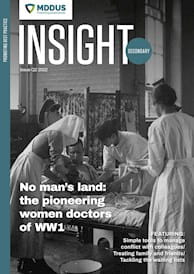 HUMAN factors are present in most adverse events and understanding those at play when things go wrong is important. This can help avoid similar incidents occurring in the future.
HUMAN factors are present in most adverse events and understanding those at play when things go wrong is important. This can help avoid similar incidents occurring in the future.
However, considering them proactively in the review and design of new systems and working practices can help to create a safer, more resilient workplace.
“Human factors” is an umbrella term often used to encompass the ways individuals work within systems. This can include how they interact with each other (colleagues, patients, carers) but also how the environment, the task, and the equipment used, affect how people work.
In many organisations, and at a department level, a significant portion of time is given to creating safe systems of working, processes, and protocols. Often these have evolved over time because of adverse incidents and a wish to make systems failsafe.
Whilst this is to be commended, and is an essential component of building safer practice, it’s also important to recognise that humans make mistakes. Sometimes processes and protocols need to be set aside – and so attempting to eliminate all risk is a futile endeavour.
Understanding the human aspects that contribute to error is key.
Modifying individual behaviour
In our experience, when a patient safety incident review blames ‘human error’, a common approach adopted is to try to modify that individual’s behaviour through retraining or “telling them not to do that again”. This approach is sometimes referred to as the ‘bad apple’ fallacy.
In practice, adopting this approach often fails to prevent similar errors recurring.
Root cause analyses (RCA) or significant event analyses (SEA) are often conducted to investigate safety events, but often they focus on individual mistakes and don’t dive deeply enough into why people made these mistakes.
Finding underlying factors
One recent analysis highlighted an individual’s “poor communication” when raising a concern, but didn’t look for any underlying factors.
For example, is there a relational difficulty with the colleague? Is there unresolved conflict that is inhibiting direct communication? Have there been historical bad behaviours across the team that influenced the individual’s approach and thus contributed to the failure to communicate effectively?
In another analysis, it was found that the individual failed to follow a guideline, but there is no mention of the reason behind this non-compliance.
For example, were interpersonal issues at play, as in the example above, or is the guideline out of date? This can often be the case when there is poor briefing in a rapid change period or organisation. Perhaps the individual was unable to follow the guideline because of a lack of resource or real/perceived support?
The real purpose of RCA/SEA is to reflect on what the incident reveals about the gaps and inadequacies of aspects of your working practices, and this should include consideration of human factors.
Don’t forget to look at why things go right
When something goes wrong, it is not only important to understand what happened, but also to work out why, most of the time, things go ‘right’. Why did a team member feel able to violate a protocol to the benefit of safety or patient care? Why are most colleagues able to challenge each other if they see something out of sorts?
By understanding this, along with taking steps to recreate the conditions in which ‘safe practices’ exist, we can help minimise patient safety incidents.
Helping safety practices thrive
So how can knowledge about human factors be ‘designed in’ to support good safety practices?
Resilience engineering – a relatively new concept - is about identifying and then enhancing and/or replicating the positive capabilities of people, teams and organisations that allow them to adapt flexibly and safely under varying circumstances and pressures. Examples include asking for help, challenging others or violating a procedure or protocol when necessary.
It starts from the premise that - despite our best efforts - no system is inherently safe and so we should be working to develop environments, capabilities and capacities that help individuals and teams cope with varying scenarios/complexity/multiple demands.
Building resilience
At the individual level
Personal reflection is key. Developing insight into personal communication styles, how you generally approach and respond to others, your work style preferences (and how these differ from others in the team, or how they impact on your patients) can be incredibly powerful.
It is also important to recognise when your capacity, or resilience, is becoming low. Fatigue, stress and (unreasonable) pressure can make you more likely to make mistakes. Knowing and practising the tools that work for you to replenish your resilience is crucial.
At the team level
Incorporating a cross-professional approach in learning opportunities can support useful interactions across clinicians when things aren’t quite working to plan. Incorporating feedback routinely into learning has been shown to encourage feedback cultures within teams, which in turn can reduce risk. If I’m doing something wrong, I’d like a colleague to feel able to tell me in a way that we’re both comfortable with.
While formal communication has its place, when it comes to patient safety, encouraging informal communication and ways to engage as a team can be invaluable.
At an organisational level
Taking time to assess the quality of interactions between management and clinical teams is important. In multi-site organisations, do management teams regularly ‘take the pulse’ of teams, including support staff, working at other locations?
Many senior managers or clinical leads are surprised to find that colleagues don’t feel empowered to raise issues to them directly, and both the nature of these relationships and culture of the organisation can impact both team morale and patient safety.
Consider how incident reporting works. Is reporting encouraged, is the process safe, and are any actions as a result of reporting and analysis transparent, fair and just?
Within the environment
Check for unnecessary distractions or interruptions. Do individuals (where appropriate) have protected time and/or space for high risk or important tasks? Is there sufficient equipment available? Lighting, and of course, ventilation are key safety factors which affect human performance – even without the Covid aspects.
If you’re in the fortunate position of being involved in the design of new workspaces, boost safety by taking into account environmental factors that can positively affect human performance.
At a technology and task level
When considering human aspects associated with tasks, factors to assess include:
- the complexity of the task
- whether individuals are autonomous or working under a protocol
- the levels of control, authority and decision-making allowed
- the individual’s ability to deviate from protocols, guidelines or set standards, including under what conditions.
All of these elements are impacted by individual and team factors such as experience levels, expertise, support and supervision levels.
When risk assessing current tasks, and how individuals engage with the technology they use in their work, be sure to involve those who ‘do’. Make sure challenges are recognised and that thresholds for safety behaviours to be enacted are understood (e.g. knowing when to ask for help).
At a patient level
Patients often need help to engage positively with their care. This can involve providing the right information at the right time or perhaps proactively building additional time into some interactions to understand specific needs or barriers, including the ability to process and retain information, ability to manage medicines, aspects that worry them and their attitude towards the clinician providing care at that time.
Organisations and teams who invest in processes or resources which support the needs of different patients are likely to be safer.
Practical steps to consider
A useful and well-accepted tool is the Systems Engineering Initiative for Patient Safety (SEIPS) model. This, plus the suggestions above, can help you risk assess human factors across your current work systems.
These can also help you anticipate the potential safety consequences of any kind of change in your practice. Whether you make them part of a risk assessment, change process or simply day-to-day practice, the feedback loops highlighted above will help ensure you have early warnings in place to focus your attention on human factors that could impact patient care, your team and the organisation as a whole.
Liz Price is Head of Training, CPD and Risk Advisory Services at MDDUS
TRAINING & CPD RESOURCES
ZOOM COURSE: Managing human factors for safe practice
This interactive workshop from our training partners at Terema is designed for any doctor to attend and also suitable for the clinical team. It takes place on June 22 from 9.30am to 12.30pm.
ZOOM COURSE: Rebuild your resilience
This interactive workshop from our training partners at Resilient Practice is designed for any hospital doctor to attend. It will help boost your communication and conflict management skills, and explores ways to enhance mental wellbeing. It takes place on April 30 from 9.30am to 12.30pm.
ON-DEMAND WEBINAR: Introduction to human factors in secondary care
THIS 50-minute webinar explores the importance of understanding and recognising human factors in dental practice, including their impact on risk and team wellbeing.
This page was correct at the time of publication. Any guidance is intended as general guidance for members only. If you are a member and need specific advice relating to your own circumstances, please contact one of our advisers.
Read more from this issue of Insight Secondary

Save this article
Save this article to a list of favourite articles which members can access in their account.
Save to library


